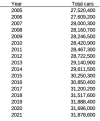Just to emphasise the information given by @Fylsie in the post quoted
the Society of Motor Manufacturers and Traders (SMMT) has just published the statistics for new car sales in 2022, see its website at https://media.smmt.co.uk/december-2022-new-car-registrations/ . This shows that 1,614,063 new cars were registered in 2022, a fall of 2% compared to the year before.
So more people may have been considering (according to the OP's quote) buying cars, but in fact didn't.
However monthly car sales did increase over the last eight months of 2022 compared to the first part of the year but not enough to cancel out the drop in the first four months. 2021 sales were affected by the pandemic and supply chain shortages and show a significant drop compared to the 2,311,140 new car registrations in 2019. Interestingly these 2019 new car sales didn't seem to have an effect on railway passenger numbers which were still growing at that time.
Maybe cars and trains are not competing for the same market...?
Interestingly if we look back at 2007 (15 years ago, so the average age of cars) there were 2,404,007 car sales, that means that during 2022 that there was about 790,000 fewer vehicles compared with those which we would have expected to have been replaced:
Which would be fine if it was just one year, however last year at 1,631,063 which was also down on the 2006 numbers 2,344,894, which was a further 713,831 fewer.
With 2020 also down at 1,631,064 with 2005 being 2,439,717, so 808,653.
However 2019, whilst at 2,311,140, was still down on 2004 which was 2,567,269 so down 256,129.
Even if we recovered to pre pandemic levels we'd need an extra 1 year's worth of sales in addition to the normal rates to bring average car ages back to where they were pre pandemic.
However it's unlikely that sales will revive quickly. As it's not just something which is limited to this country.
This could cause issues.
The problem is that if we are also reducing rail and bus capacity then it could well be that it starts to get harder and more expensive to get about, regardless of your preferred mode of transport.
To put this in perspective, if we assume we add 10% to the 2022 numbers to get to the 2023 numbers (and so on), it would take 5 years to get back to sales of 2.6 million new cars and we'd have baked in a further 6 months of new cars sales which were missing (i.e. we'd have a total backlog of 18 months of car sales). Now we could out perform 10% growth year on year. However it's likely that will end up with between 15 and 18 months of backlog - unless things don't start to improve soon and then a 24 month backlog (or more) isn't that unlikey.
The one area which could help keep that backlog down is that between 2009 and 2013 the rolling 12 month total averaged out at about 2 million a year.
That's going to keep car prices high for some time, however it pans out.
The longer that lasts the more costly car ownership is going to be (which isn't good for those who wish to drive) but if there's cuts to rail services there's not going to be viable options for people to use. Without those viable options there's a risk that it would put more towards pressure on car prices.
It's another reason that arguably we shouldn't be looking to making cuts to rail services until we have a better idea of how this is going to plan out.

